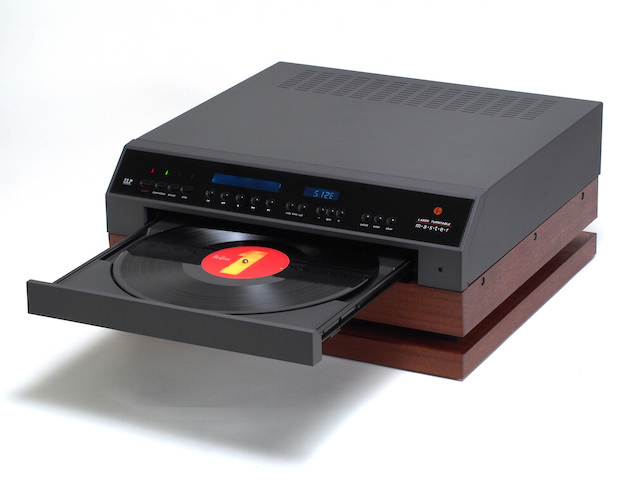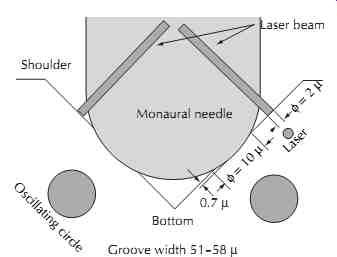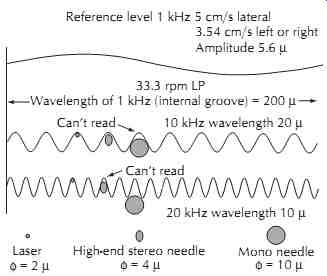|
|
. The Laser Turntable (LT) is manufactured by the ELP Corporation, Japan, FIG. 28. It features a contact-free optical pickup system allows records to be played thou sands of times without damage to the record. The LT operates with five laser beams, three of which stabilize the groove and two that read the analog audio information from the record. The first two beams aim at the left and right shoulders of the groove for tracking. The next two read the stereo sound at 10 microns below the shoulder (the standard position). The final beam maintains the height between the laser head and the surface of record to manage thicker or warped records. The LT eliminates acoustic feedback and sound alteration and will play warped and rippled records (up to 5 mm deviation). For convenience, the LT comes with a remote control and can be paused and scanned much like a CD player.
The same audio information on records is engraved from the shoulder to the bottom of a record groove. The laser reads audio information that is 10 microns below the shoulder, FIG. 29, therefore, the laser picks up audio information which has not been touched or damaged by a pickup. It plays the virgin audio information on the groove without digitization.
The incident area of the laser beam on the groove is one-fourth the contact area of the best stereo needle and twenty-six times smaller than a mono needle, FIG. 30. The laser beam travels to the wall of the groove and back. The reflection angle is transferred to the audio signal. Therefore, the LT maintains analog sound through the entire process, without any digitization. As a result, the LT cannot differentiate between an audio signal or dirt on the record, so the vinyl record must be absolutely clean and free of debris.

FIG. 28. ELP Laser Turntable. ELP Corporation.

FIG. 29. The laser beam picks up the signal closer to the shoulder where
the standard needle does not touch.
The laser beams must reflect from an opaque surface in order to be read. Clear or colored records are trans parent, or translucent, and will not reflect light to the sensors. Other types of records that may have difficulty include:
• Vertical cut records like the early Edison "Diamond Cut" series. The modulation is up and down rather than lateral.
• Rounded groove shoulder.
• A groove with a rounded bottom produces distortion.
=========

FIG. 30. The incident area of the laser beam is one fourth the size of a
stereo needle and twenty-six times smaller than a monaural needle.
Wavelength of 1 kHz (internal groove) = 200 M 33.3 rpm LP Reference level 1 kHz 5 cm/s lateral 3.54 cm/s left or right Amplitude 5.6 M Can't read; Can't read; 10 kHz wavelength 20 M 20 kHz wavelength 10 M; Laser Mono needle; High-end stereo needle F = 2 M F = 4 M F = 10 M
=========
No Acoustic Feedback or Sound Alteration. Feedback is typically caused by sound from the loudspeakers (or from elsewhere) reaching the turntable and mechanically picking up the vibrations, to be amplified again.
There is no needle singing. The LP is safely in a drawer and the laser reads only the undulations of the groove, therefore there is no need for elaborate vibration isolation pads. The LT will not hear outside noises such as footsteps on the floor, door slamming, or other vibrations in the area.
Operating the Laser Turntable. When a record is placed in the drawer and the play button pressed, the record tray closes and the LT scans the disc to identify the various bands or cuts. The bands are displayed on the front panel Record Profile LCD display. A single vertical line above the bands indicator shows the position of the laser pickup head. The vertical indicator travels across the record as it is played, showing its exact position on the record, and which band is playing.
On the initial scan the laser head moves from the inside (spindle) to the outside track while marking the bands. The machine then moves into the first band and measures the distance from the head to the record surface. After a few seconds the record will begin playing from the beginning.
The LP can repeat the same record up to five times, repeat a cut, listen to a segment of the cut, play a single grove segment repeatedly, or play selected bands in any order.
When a record starts to play, the message window displays the rpm of the platter. When a record is playing, the display shows the elapsed running time, the elapsed time of the current cut, the remaining time of the side, and total time of the side.
============